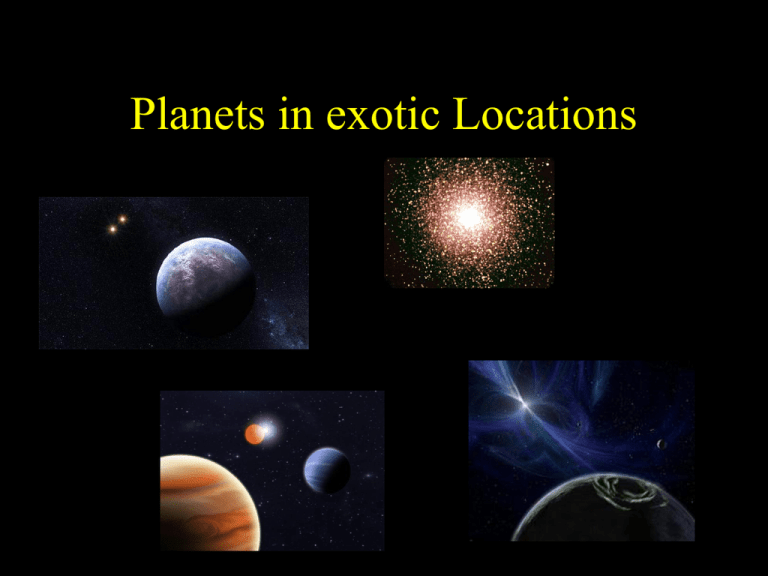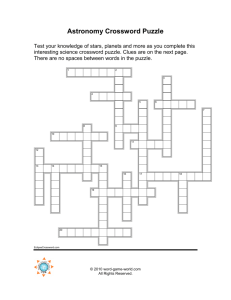Planets in exotic Locations
advertisement

Planets in exotic Locations Exotic I: Planets around Pulsars The Progenitors to Pulsars: Exploding Massive stars The burning stages of massive stars Main sequence lifetime ~ 10 million years Helium burning ~ 1 million years Carbon burning ~ 300 years Oxygen burning ~ 2/3 year Silicon burning ~ 2 days After Si burning the core collapses resulting in a supernova explosion. What is left behind is a neutron star. These are Type II supernova The „Lighthouse“ Beacons of Pulsars Properties of Neutron Stars (Pulsars) Progenitor Mass: 8-20 Msun Remnant mass: < 3 Msun (otherwise it becomes a black hole) Pressure support: Neutron degeneracy pressure Radius: ~10 km Density: 200 million tons/cm3 Magnetic field strength: ~ 1013 Gauss Periods: 1.5 millisecs to 8.5 s Rotation period of B1937+21: P = 0.0015578064924327 ±0.0000000000000004 secs These are very stable clocks! => timing method A shaky start: Nature 1991 1992: initial position of the pulsar used in the barycentric motion of the Earth was off by 7 arcmin They detected the eccentricity of the Earth’s orbit The (Really) First Exoplanets: in 1992 Arecibo Radio-telescope 98 d orbit removed, 66 d orbit remains 66 d orbit removed, 98 d orbit remains PSR 1257+12 system: Planet A: M = 0.02 M_Earth P = 25.3 d ; a = 0.19 AU Planet B: M = 4.3 M_Earth P = 66.5 d ; a = 0.36 AU Planet C: M = 3.9 M_Earth P = 98.2 d ; a = 0.46 AU fourth companion with very low mass and P~3.5 yrs Interaction between B & C Confirms the planets and Establishes true masses! Planets C & D near 3:2 resonance => interact gravitationally! These effects were observed in PSR 1257+12 (Wolszczan 1994) Very strong evidence that this planetary system is real! Rasio et al. 1992 •Pulsar with a 0.3 Msun mass companion in a 191 d orbit • After removing the timing variations of the stellar companion there are additional variations in the residuals • Phinney 1993: Period variations due to planet 14-400 Mearth with P > 15 yrs. • Thorsett et al. 1993 : Variations are consistent either with a planet at ~10 AU, or a star at ~50 AU orbit This planet is uncertain. Currently there is only one pulsar with planetary companions Origin of the Pulsar Planets 1. First Generation Planets: These „rocks“ are remnants of planets (maybe giant planets) that survived the supernova explosion 2. Second Generation Planets: Planets that formed in the debris disk left behind after the supernova explosion (more likely) Debris disk found around another pulsar fits this picture! Unfortunately, we only have one example of a pulsar with planets, until we find more such systems the nature of pulsar planets will be unknown. Exotic II: Pulsating white dwarfs & sdB stars and eclipsing WD binaries (NN Ser & DP Leo) We Can Observe White Dwarfs for Timing • But first, what is a White Dwarf? • The geriatric remains of sun-like stars • All stars with masses less than 8M will become white dwarf stars The Timing Method With White Dwarf Stars • White Dwarf stars are extremely small (radius ~ Earth) • Their mass is comparable to the sun, so they are extremely dense • Radial velocity impossible on such broad spectral lines • Observing planetary transits is improbable • Imaging studies have so far been unsuccessful • White Dwarf stars provide a few different stable “clocks” • Binary White Dwarf stars = eclipses • Pulsating White Dwarf stars = time of arrival of pulses WD Searching for Planets Around Oscillating White Dwarfs Optical Light Curves of ZZ Ceti Stars Mullally et al. (2008, ApJ, 676, 573) looked at a sample of 15 pulsating white dwarfs One white dwarf, GD 66 looks promising: But the amplitude of the mode shows variations Arrival time variations consistent with a ~2 MJup companion in a 4.5 year orbit…but one has to be careful: 1. Evolutionary changes can cause period changes 2. Unstable modes can cause period changes 3. Beating of modes can cause period changes (WD stars tend to be multiperiodic pulsators). Subdwarf B Stars (sdB) • sdB stars are believed to be core He-burning stars of 0.5 M on the extended horizontal branch that have lost their envelope • Teff ~ 22.000 – 40.000 K • Periods 100 – 250 secs V391 Peg sdB stars in the HR diagram: sdB stars O-C for two pulsation frequencies look the same Sub-stellar Objects in Strange Places: The Sub-stellar companion to the sdB star HD 149382 found with traditional radial velocity variations A 8-20 MJup mass object in a 2.9 d orbital period…so why is this interesting? P = 2.9 days → a = 0.05 AU (assuming a 2 solar mass star) = 10 solar radii. On giant branch: Stellar radius 10-50 Rsun At one point this companion was in the envelope of the star! Planets around the cataclysmic eclipsing binary NN Ser Not to scale! Orbital Period 3.12 hours White Dwarf: Mass: 0.535 Solar masses Temperature = 37000 K Mass transfer M4 Dwarf companion: Mass: 0.11 Solar masses Temperature ~ 3000 K NN Ser is an eclipsing system. If there are additional companions around one or both stars this will change the expected time of the eclipse. UT Case Study: NN Serpentis • Eclipses, which occur every 3.120 hr, are the “clock” • We observe this clock for any deviations (for example, say we see 3.119 hr between eclipses, or 3.126 hr) Parsons et al. 2010, MNRAS 402 2591 One planet fit to the variations in the eclipse timing: P1 = 15.5 years M1 = 6.9 MJup 2:1 resonance Two planet fit: P2 = 7.7 years M2 ~ 2.2 MJup These planets have to be circumbinary planets: X Formation scenarios: First or Second Generation planets • First Generation: Planets formed with stars, but these would have to have survived the supernova explosion • Second Generation: Planets formed after the common envelope phase • Are they planets at all? Dynamical stability in question! Planets around the cataclysmic eclipsing binary DP Leo Orbital Period = 89 minutes White Dwarf companion with Mass > 1 Solar mass Companion is a cool star that is transfering mass to the W.D. DP Leo is a post Common Envelope star (CE). During the evolution of the W.D. the secondary was in the envelope of the companion star. Exotic III: Planets in globular and open clusters HST transit search for hot Jupiters in 47 Tuc Only 120 light years across! HST transit search for hot Jupiters in 47 Tuc • Targets: 47 Tuc Main Sequence Stars (number of usable targets ~34000) • Telescope Time Allocation: 8.3 X 24 hours, continuous observation (120 X 96.4-min HST Orbits) • Observations schedule: 1999 July 3-11 • Data Obtained: • 636 F555W Images (exposure time: 160 sec per image) • 653 F814W Images (exposure time: 160 sec per image) • Number of Planetary Transits expected: • about 1% of Main Sequence Stars of the Solar Neighbourhood host a Short-Period Planet ("Hot Jupiters") • Transit Probability for the Hot Jupiters: ~ 10% • Therefore 1 Transit/1000 Stars is expected • 30-40 Transits for the full surveyed Stellar Sample are expected if the 47 Tuc Planet occurence is the same as in Field Stars • Results: • No Planetary Transit Detected But: dynamical environment and [Fe/H]=-0.7! An ancient planet in M4 orbiting a pulsar/WD binary •Timing residuals in pulsar PSR B1620-26 reveal a high-mass companion • Additional residuals point toward a 3rd body, could be planet orbiting both stars at large separation. • HST detected 2nd body => WD Assuming co-planarity 3rd body = planet with ~2.5 Mjup with P~100yrs and age of 12.7 Gyrs! The Hyades The Hyades • Hyades stars have [Fe/H] = 0.2 • According to V&F relationship 10% of the stars should have giant planets, Paulson, Cochran & Hatzes surveyed 100 stars in the Hyades • According to V&H relationship should have found 10 planets •But found zero planets! Something is funny about the Hyades. Is it their youth (650Myr) and activity level? The problem with active stars: In 1996 Michel Mayor announced at a conference in Victoria, Canada, the discovery of a new „51 Peg“ planet in a 3.97 d. One problem… HD 166435 shows the same period in in photometry, color, and activity indicators. This is not a planet! Exotic IV: HD 188753 Ab : an impossible Planet? Konacki et al. 2005: An extrasolar giant planet in a close triple-star system (aka the Tatooine planet search) HD 188753 A & B: A planet ?? m sin i = 1.14 Mjup P=3.4 d P~26 yrs Another 3rd star: P = 156 d This would be extremely interesting as protoplanetary disk was truncated at ~1.3 AU, well inside the ice-line! Capture scenario for 2nd star? Eggenberger et al. 2007: No evidence for HD 188753 Ab! Eggenberger et al. 2007: No evidence for HD 188753 Ab! Eggenberger et al. 2007: No evidence for HD 188753 Ab! Exotic V: HIP 13044 b: a planet from outside the Milky Way? Setiawan et al. (2010): HIP 13044, a highly evolved star, is orbited by a giant planet with P=16.2 days J Setiawan et al. Science 2010;330:1642-1644 HIP 13044 is extremely metal-poor! ..and belongs to the Helmi stellar stream that consists of stars that originally belonged to a dwarf galaxy that merges with the Milky Way: We know little about about the RV behavior of this type of star. HIP 13044 shows signs of variability of its spectral lines: I’m not convinced this is a real planet…. Exotic Planets Summary: • A multi-planet system around a milli-second pulsar • Candidates around pulsating white dwarfs (GD 66) , one sdB star (V 391 Peg) and eclipsing WD systems (NN Ser & DP Leo) • No planets in globular cluster 47 Tuc and open cluster Hyades, one candidate in globular M4 • “Impossible” planet HD 188753 Ab is not real • HIP 13044 b, a giant planet of extragalactic origin?





